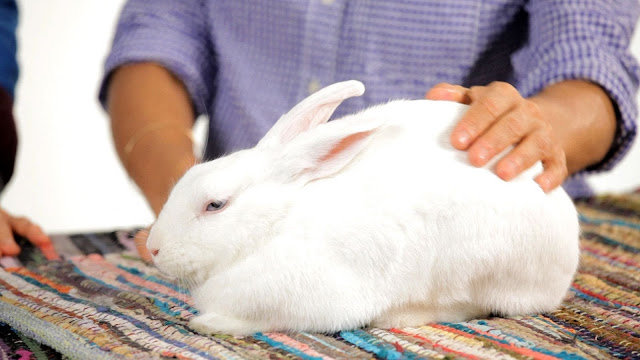Soaring to New Heights: Can Rabbits Love High Jumping?
When you think of rabbits, you might envision their endearing twitching noses and fluffy tails rather than their athletic abilities. However, there's more to these small, unassuming creatures than meets the eye. Among their many surprising talents, high jumping stands out. But do rabbits truly love high jumping? Let's delve into this intriguing aspect of rabbit behavior with a human touch.
The Natural Jumpers: Rabbit Anatomy
Rabbits have a remarkable physiology built for agility, and high jumping is a testament to their natural athleticism. Their powerful hind legs, designed for propulsion, enable them to leap with grace and precision. These legs are like coiled springs, storing energy for the perfect launch.
Rabbits also possess a unique skeletal structure that's tailor-made for jumping. Their lightweight bones and strong muscles allow them to execute impressive feats of athleticism. While rabbits may not rival Olympic high jumpers, their jumping prowess is undeniable.
Jumping in the Wild: A Necessity for Survival
In the wild, high jumping is more than a pastime; it's a survival skill. Wild rabbits rely on their ability to leap to evade predators and navigate their environment. When faced with danger, a rabbit's immediate reaction is often to bound away to safety, leaping high and far.
Their keen senses of sight, smell, and hearing help them detect potential threats, and their agility allows them to react swiftly. It's a ballet of life and death in the wild, and high jumping is a crucial dance step in the rabbit's choreography.
Domestic Rabbits: High Jumping Enthusiasts?
Now, let's transition to the world of domestic rabbits. These charming pets often retain their wild ancestors' instincts, including their love for jumping. For many pet owners, witnessing their rabbits engage in high jumps is a source of delight. But do they truly love it?
The human touch here is about understanding the motivations behind a rabbit's high jumps. Domestic rabbits may not be jumping to escape predators, but they do it for other reasons. It's a form of play, exercise, and, in some cases, a display of excitement. When rabbits are hopping and leaping, they're often expressing their exuberance and contentment.
Rabbit Playtime: Joy in High Jumps
Rabbits are playful creatures, and their playtime often involves high jumps and bursts of energy. It's a sight to behold, watching a rabbit perform binkies, those joyful, acrobatic leaps that exude pure happiness. Binkies are the epitome of rabbit enjoyment, and they often occur during play or when a rabbit is particularly content.
High jumping can also be a form of exploration for rabbits. They might hop onto furniture, investigate new objects, or attempt to reach hidden treats. It's their way of engaging with their surroundings and satisfying their curious natures.
The Bond Between Humans and Jumping Rabbits
As rabbit owners, we share a unique bond with our furry companions. When a rabbit performs high jumps in our presence, it's often a sign of trust and comfort. Rabbits are sensitive animals, and their willingness to engage in such behavior when they feel secure speaks volumes about the quality of their human relationships.
The human touch in this context is acknowledging and celebrating the joy that high jumping brings to both rabbits and their owners. It's about providing a safe and stimulating environment where rabbits can express themselves through their natural behaviors, including high jumping.
High Jumping: Encouraging and Safe
If you're a rabbit owner, you may be wondering how to encourage and ensure safe high jumping for your furry friend. Here are some tips:
Safe Environment: Create a safe and rabbit-proofed area for play where there are no sharp objects, wires, or other hazards that could harm your rabbit.
Supervision: When your rabbit is engaging in high jumps, keep a watchful eye on them to ensure they don't get into any trouble or injure themselves.
Stimulation: Provide toys, tunnels, and obstacles that encourage jumping and exploration. This keeps their playtime engaging and enriching.
Positive Reinforcement: Offer verbal praise and occasional treats to reinforce your rabbit's play and jumping behavior. This positive feedback can strengthen your bond.
Gentle Play: When interacting with your rabbit, engage in gentle play that encourages their natural instincts. Avoid overwhelming them or pushing them to jump excessively.
Limits and Caution
While high jumping is a beloved rabbit behavior, it's essential to be mindful of your rabbit's limitations. Not all rabbits have the same jumping abilities, and some may be more reserved in their approach to play. Avoid pushing your rabbit beyond their comfort level, and if you notice any signs of exhaustion or distress, allow them to rest.
Additionally, be cautious with the height of jumps. Rabbits are excellent jumpers, but jumping from excessive heights can result in injuries. Always prioritize your rabbit's safety and well-being.
In Conclusion: The Love for High Jumping
So, can rabbits love high jumping? While rabbits may not experience love in the human sense, their high jumps are undeniably an expression of joy, contentment, and their innate playfulness. High jumping is an integral part of a rabbit's natural behavior, and when observed with a human touch, it becomes a delightful and heartwarming aspect of the bond between rabbits and their owners.
For rabbit owners, the sight of their furry companions leaping with exuberance is a testament to the happiness they bring into our lives. It's a reminder that the connection between humans and rabbits transcends words and is beautifully expressed through the language of high jumps and binkies.




Comments
Post a Comment